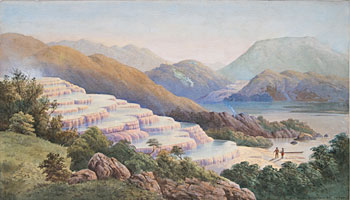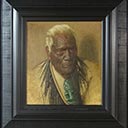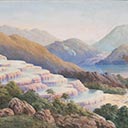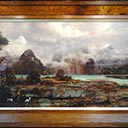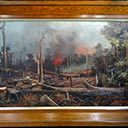Pink Terrace, Rotomahana
40 x 70 cm
est. $25,000 - 35,000
PROVENANCE
Benjamin Giles Collection, Sydney until 1987
By descent Jennifer Cahill, Sydney
Private Collection, Sydney
Prior to the Tarawera eruption in the early hours of June 10, 1886, the Pink and White Terraces on the shores of Lake Rotomahana near Rotorua, were considered the eighth wonder of the natural world. They were formed over thousands of years from the geothermally-heated, silica-laden water of two large geysers which once cooled, crystallised into giant staircases and waterfalls. Visiting missionaries and European traders were stunned by the beauty of the Terraces and word soon spread attracting growing numbers of visitors. These magnificent natural structures became New Zealand's earliest and most famous tourist attraction.
The Pink Terraces/ Otukapuarangi in Maori, translates to fountain of the clouded sky whilst the White Terraces/Te Tarata means the tattooed rock. The White Terraces were the larger formation, covering 3 hectares and descending 30 metres. The Pink Terraces were where people went to bathe on the lower levels as the temperature of the water was lukewarm. When Mount Tarawera erupted, Lake Rotomahana was buried, and the Terraces were thought to be lost forever. Paintings such as this, along with early black and white photographs, are visual reminders of a natural creation shrouded in mystery and illusion which lives on in our collective psyche.
J.C. Hoyte was born in England (probably London) on December 22, 1835, the son of Samuel Hoyte, a landowner. In 1860 he and his wife Rose, left England aboard the Egmont bound for Auckland. On arrival, Hoyte is thought to have worked as a customs clerk before embarking on a career as an art tutor, watercolourist and importer of artists' supplies. He taught drawing and other subjects at the Church of England Grammar School between 1862 and the 1870s, and also at Wesley College in Queen Street and Auckland Grammar School. As his career as a painter developed he travelled extensively through New Zealand and began to play a prominent role in the Auckland art world. In 1869 Hoyte was one of the founders of the Auckland Society of Artists. He was also active in church affairs, serving for a time as vestryman at St Mary's Church, Parnell. He was a member of the volunteer militia and lived in Scarborough Terrace, Parnell. In addition to his role in the art societies of Auckland and Dunedin in 1880 he was co-founder of the Art Society of New South Wales and a member of the Victorian Academy of Art.
This pristine watercolour is an excellent example of a work by J C Hoyte . An inscription and title to the lower right (rarely seen in a work by this artist) further enhances the offering.

